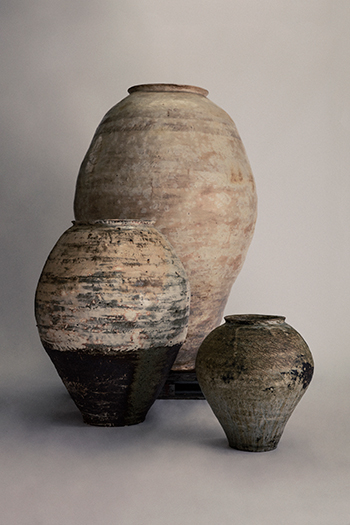Greater Jars and Ordinary Vessels:Turning Fray into Faculty
Atsushi Ogata
November 25, 2017 – December 20, 2017
GALLERY HOURS :11:00 – 19:00
GALLERY CLOSED:
SUNDAY, MONDAY, PUBLIC HOLIDAY
RECEPTION:Saturday, November 25, 2017 18:00 –

Atsushi Ogata: The essence of the artist magnified in new larger-than-life ceramic jars
Kaikai Kiki Gallery is pleased to announce a solo exhibition by ceramicist Atsushi Ogata, “Greater Jars and Ordinary Vessels: Turning Fray into Faculty,” starting Saturday, November 25th.
Atsushi Ogata began his seemingly unlikely career in ceramics after being an editor-in-chief of a magazine. In 1996, Ogata broke free from his office worker lifestyle to start anew as a student at the Aichi Prefectural Technical College for Advanced Ceramics, where he first began to learn the art of ceramics. Upon graduation, he began producing works in the city of Seto, Aichi. In 2007 he relocated his studio to Nara, which remains the home base of his production today.
Using a noborigama (climbing kiln) which he constructed himself in 2009, Ogata creates ceramic works using clay as his main medium. The artist leaves his works unglazed in order to emphasize the expressive quality and texture of natural soil clay. Many of his pieces make use of the hakeme technique (lit. “brushmark”, in which brush strokes are used to create patterns on a piece) and the kohiki technique (lit. “dust blowing”, in which white porcelain powder is dusted onto a piece).
Following in the same vein as his 2012 solo exhibition at Oz Zingaro, “Large Jars and Ordinary Vessels,” this exhibition will showcase around 1,000 of Ogata’s trademark ceramic dishware, as well as a dozen or so large jars and—surpassing the scale of even his last exhibition—a series of five colossal new jars each towering almost over two meters tall.
Going back and forth between his studio in Nara and Shigaraki Ceramic Cultural Park, Ogata went to work on creating his colossal jars for this exhibition, but in the process felt a distance forming between himself and his familiar territory of utsuwa (vessels). Being forced to face this feeling, he realized that he was most drawn to pieces that retained their quintessential presence as utsuwa even if cracks and chips formed in the piece. Through this process, Ogata came to reaffirm that this touch of hokorobi, or fray, was the key element of his individual style. Returning to the roots of his artistic approach, Ogata strived to utilize size and shape in such a way as to bring out the flavor of the material to it’s maximum. While keeping a firm foundation in utsuwa, the artist was able to set his sights upon other things, and that was the stance that allowed him to finally complete his new monumental pieces.
We hope you will witness the essence and evolution of Ogata Atsushi’s works as he challenges his own limits through this exhibition.